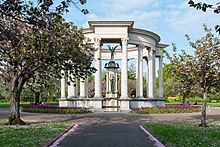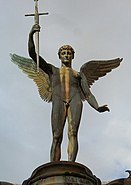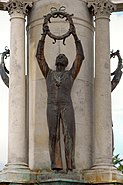|
Welsh National War Memorial
The Welsh National War Memorial (Welsh: Cofeb Ryfel Genedlaethol Cymru) is situated in Alexandra Gardens, Cathays Park, Cardiff. The memorial was designed by Sir Ninian Comper and unveiled on 12 June 1928 by the Prince of Wales. The memorial commemorates the servicemen who died during the First World War and has a commemorative plaque for those who died during the Second World War, added in 1949. Design and constructionWelsh National War Memorial statues Victory on top of the central stone pylon Sailor (Navy) surrounding the central stone pylon Soldier (Army) surrounding the central stone pylon Airman (Air Force) surrounding the central stone pylon The memorial was first suggested in 1917.[3] However, detailed proposals were not established until October 1919 when the Western Mail created a national subscription fund and a committee set up to manage the scheme.[3] There were four designs submitted to the committee and the design selected was by Sir Ninian Comper and approved in 1924.[3] The sculpture was by Henry Alfred Pegram.[4] The stone masons were William Drinkwater Gough and Messrs E. Turner & Sons.[4] The bronze statues were cast by A. B. Burton.[4] The memorial is the only secular work by Comper, who was primarily a furnisher of churches. He received much hostility, from the president of the Royal Institute of British Architects and others, for not being a qualified architect, but was supported by the sculptors Sir William Goscombe John and Sir Hamo Thornycroft.[5] The memorial takes the form of a circular colonnade surrounding a sunken court. On the frieze above the columns are inscriptions in Welsh, on the outer side, and in English, on the inner side. The English inscription was composed by Comper himself. At the centre of the court is a group of three bronze sculptures arranged around a stone pylon. Around the base stand three figures, a soldier, sailor and airman, holding wreaths aloft. There are appropriate inscriptions above the figures, e.g., "Over the sea he went to die" above the sailor. Above them, crowning the structure, is a winged male nude representing Victory. The memorial's form was inspired by two visits to French North Africa and particularly Tunisia, where the architect was inspired by the public works erected by the emperor Hadrian. In order for Pegram to find a model for the bronzes, the crews of two battleships were invited to the Union Jack Club in Waterloo, London. The sculptor selected a young sailor called Frederick William Baker, an Englishman from Brixton, in the nude and in uniform.[5] The memorial was unveiled on 12 June 1928 by Edward, Prince of Wales.[6] The ceremony was broadcast by the nascent BBC.[6][7] The Memorial is Grade II* listed.[2] See alsoSources
References
External links
Information related to Welsh National War Memorial |
||||||||||||||||||||||||||||




